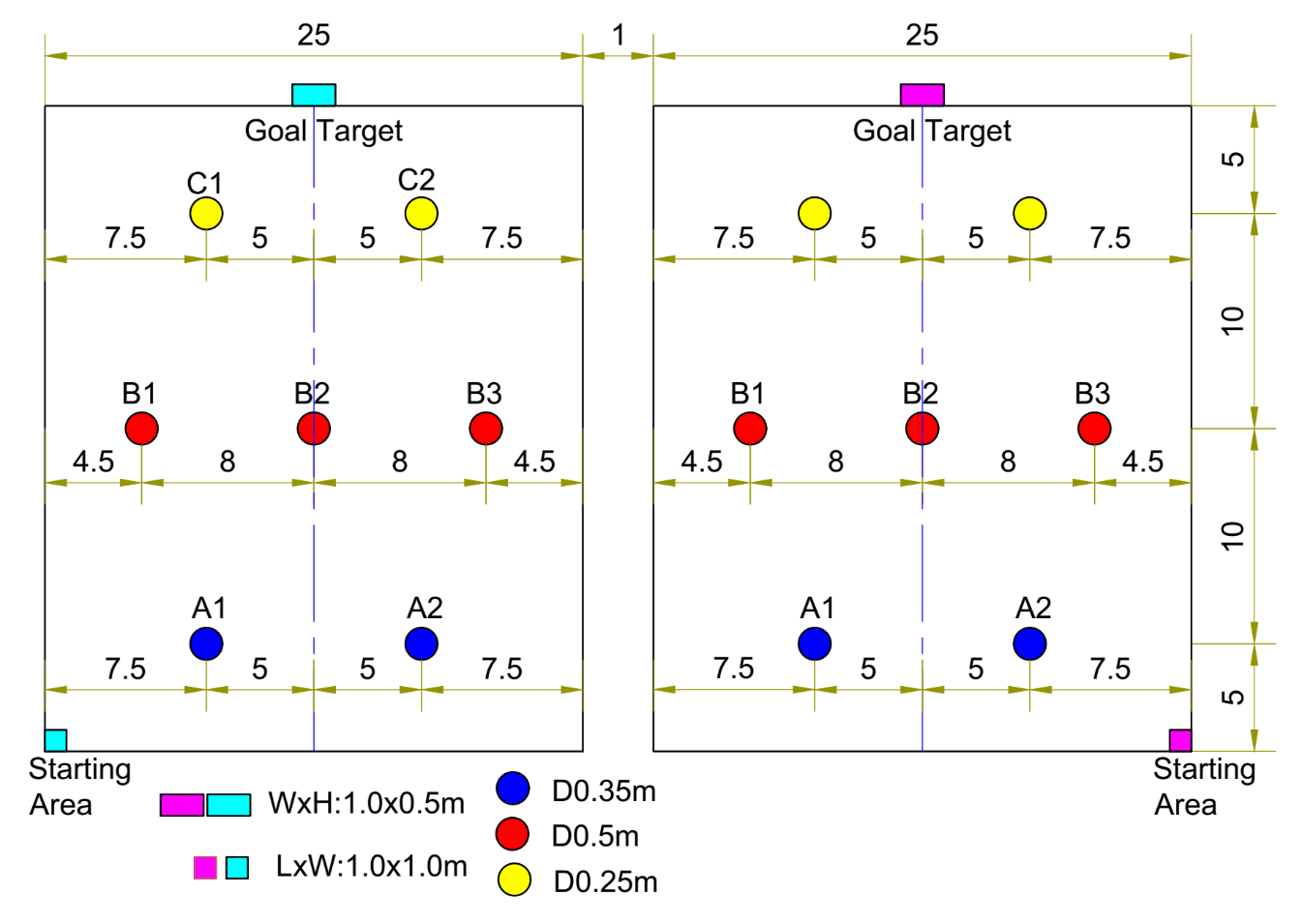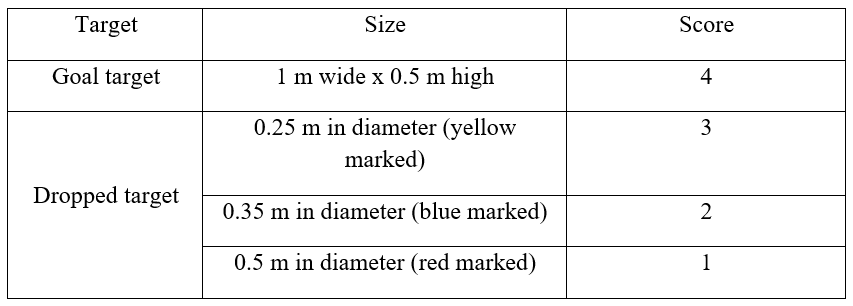Competition rule
- Chapter 1: Topic and task
-
The topic of the first International Drone (UAV) Competition is called “DroneBall” (find the target and drop/shoot the ball).
Task
The goal of the competition is to develop a control application for a UAV (drone) that will allow the standard tennis ball(s) (diameter from 2.5 inch (6.25 cm) to 2.63 inch (6.57 cm) and weight from 56.0 gram to 59.4 gram) to be dropped/shot in a target. There is total 5 targets for each team, including 4 independent dropped targets with different sizes located in random positions, and one goal target. Allocation and size of the targets are depicted in Fig.1 below. Some of the targets will be challenged with aggravating conditions such as smoke, water vapor, etc. The task will be to drop an object in the target from pre-defined heights with the greatest possible accuracy of impact.It is possible to use a thermal camera, a GPS receiver, a normal camera and other sensors to solve the given task.

Fig. 1: Competition Areas and Target Specifications. The independent dropped targets includes one A position (select one randomly from A1, and A2) , two B positions (select two randomly from B1, B2, and B3) and one C position (select one randomly from C1, and C2).
Competition area specification:
- Each team will complete their task in their own competition field to avoid the collision of UAVs.
- UAV navigation will take place autonomously - again at the discretion of each competing team
- Targets will be marked on a tarpaulin that will be firmly attached to the ground
- Target recognition, or Primary data processing can take place either directly on the UAV or on the user's PC (control center). Again, this is for each competing team to consider.
Competition place and date:
- The competition place will be at TDTU indoor gymnasium.
- The competition date will be announced two months in advance.
- Chapter 2: UAV Specification
-
General requirement
The UAV/Drone used in the competition must be designed and assembled by the competition team. Commercialized drones or UAVs are not permitted.Weight and size: The total weight of the drones is not limited; The size of UAV/drone must fit within the starting area of 1 m2.
Motorization: Only electric motors are allowed; No limitation on battery and voltage level
Propellers: No limitation
Radio control equipment: The following RF bands are allowed for the radio control units: 2.4 GHz, 5 GHz, …
- Chapter 3: Competition rounds
-
Qualification round: Teams are divided into two groups. The format of this round is round robin qualification.
For each match:
- The winning team gets 3 points, the losing team gets 0 point
- In case of a tie, each team gets 1 point
- The two teams with highest points of each group will go to the next round.
Semi-final round: Four teams from qualification rounds are divided into two matches; the winners will advance to the final round; the runner ups will get the bronze prices.
Final round: Two winning teams in the semi-final rounds will compete for the championship.
- Chapter 4: Competition rules
-
Match
Each match consists of two games lasting 10 minutes each for a total of 20 minutes (not include the preparation time)
- Game 1: Automatic control
- Game 2: Manual control
The team has the higher scores from both games will win the match. The game will stop immediately if one team scores all of the targets, so called knockout punch.
In case of a tie (in semi-final and final rounds) when both teams have same scores, a penalty game will be applied. In the penalty game, both teams will compete by dropping/shooting ball to the goal target using manual control. The team which can score in a shorter time will win the game.
Score
Teams get score when the balls sit in the targets. The scores are set as shown in Table 1.
Table 1: The achieved score for different targets

UAV flying altitude
- The required UAV flying altitude is at least 5 m above the floor.
- There will be a laser beam that sweep at the required altitude. The referee will watch and send the warning if the UAV flies below the sweeping laser beam.
Teams
- Each team can have at most 5 members.
- Each team can have at most 4 UAVs. Before each game, the competitor can select the UAV and register it with the referees. The registered UAVs must be checked by the referees for satisfying the specification before being able to fly.
Balls
- Each team gets 5 standard balls for each match. The UAV can carry 5 balls at a time or can carry single ball from time-to-time depending on the team’s design and strategy.
- In case of dropping ball by accident or dropping balls out of the target, each team can get 3 extra balls to continue their task. The extra balls are only used when out of standard balls and the targets are not fully scored.
Disqualification
A team may be disqualified from a race in the following circumstances:
- Start before the start signal.
- Does not show up at the competition area when at the assigned flying time
- Collision with another UAV that is in official flying.
- Attempt to do jamming on the radio control of the flying UAV from other teams
- Fail to satisfy the safety requirements.
The disqualification is decided by the judges assigned to the concerned team.
- Chapter 5: Documentation
-
The following documents must be submitted by each participating teams at least one month prior to the main competition date:
- A registration form.
- A technical specification of the UAV(s) that are going to be used in the competition, including the following information: drawing of the UAV, block diagram, schematic of each module, bill of materials, design procedure, programming algorithm(s).
- Consent form
- Chapter 6: Safety requirements
-
Teams must have available personal protective equipment (PPE) (tools, gloves, eye protection, hearing protection, etc.), safety risk mitigation (training, checklists, radios, etc.) and equipment to support rapid response to accidents (first aid kit, fire extinguisher, etc.) as needed.
The pilot of each team must control his UAV following the requirements:
- Not fly a model aircraft in a careless or reckless manner.
- Not operate any model aircraft while under the influence of alcohol or any drug that could adversely affect ability to safely control the drone.
-Avoid flying directly over unprotected people, moving vehicles, and occupied structures.